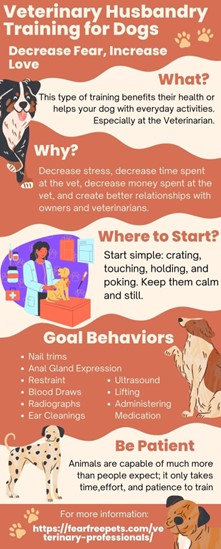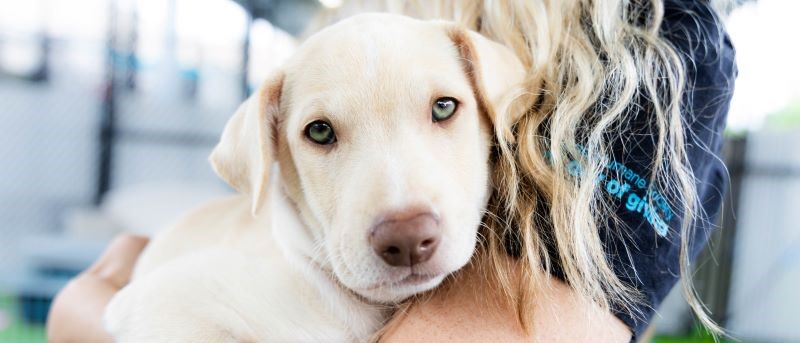What is Husbandry Training, and Why is it Important for Your Furry Friend
By Cindy Tanaka
Published: Sept. 27, 2024
Training can improve the welfare of all animals, from lions to rabbits and so many more. Nevertheless, some people don’t realize that the training they can do at home can improve their companion animals' lives. Working at a veterinary hospital inspired me to educate more pet owners so that they can be more proactive in their pets' health. Husbandry training uses positive reinforcement, a type of operant conditioning that can help pets participate in their own healthcare. Positive reinforcement is giving a tasty treat to encourage a certain behavior while operant conditioning is a style of training using rewards and punishment (3,4). This specific type of training is specifically for behaviors that benefit health or help an animal with everyday activities. Husbandry behaviors can be simple, like practicing crating, touching, moving, and walking. Not only will veterinarians thank you for training these behaviors in advance, but so will your pet.  If pets are trained at home, it will decrease stress, decrease time and money spent at the vet, and create better relationships between owners, veterinarians, and pets (2,9). It is important for exotic and domestic animals to have regular veterinary check-ups to detect emerging health problems early to ensure a long healthy life (1). With husbandry training, animals are able to participate in their health with less stress through positive reinforcement.
If pets are trained at home, it will decrease stress, decrease time and money spent at the vet, and create better relationships between owners, veterinarians, and pets (2,9). It is important for exotic and domestic animals to have regular veterinary check-ups to detect emerging health problems early to ensure a long healthy life (1). With husbandry training, animals are able to participate in their health with less stress through positive reinforcement.
Scientists and animal caretakers have long realized the importance of animals voluntarily participating in research through positive reinforcement training. Likewise, zookeepers are able to train individuals of a wide variety of species to do many different behaviors. For example, as part of husbandry training, animals in managed care can be trained to voluntarily participate in veterinary procedures. Some procedures individuals can be trained to participate in are phlebotomies, radiographs, foot care, injections, ultrasounds, urine collection, and medication administration (11). Historically, a zoo animal would need to be sedated (chemical restraint) or restrained (physical restraint) to have samples or vital readings taken. Chemical restraints often come with risks that vary between species; too much or too little sedation can result in death (7). Meanwhile, physical restraint can be very stressful and there is always a risk of individuals getting seriously harmed. With recent advancements in husbandry training, both zoo and companion animals can voluntarily participate in their own medical care, reducing the risk of harm to both the animal and their handlers (9).
Desensitization training is key to veterinary care in the exotic and domestic worlds. This technique is slowly and gradually introducing a fearful stimulus over time until reaction is minimal (7). Nail trims, anal gland expression, restraints, blood draws, radiographs, and ear cleanings all require companion animals to stay still and calm (11). Training allows veterinarians to examine, treat, and collect samples without stress or sedation, which can also provide more accurate testing results (5).
Animals are capable of more than people expect; it only takes time, effort, and patience to train (9). Ken Ramirez, a highly recognized animal trainer, states that training should not be seen as a luxury; it is essential for good animal care and should not be neglected (7). Marine mammals are trained for routines such as voluntary blood draws, ultrasounds, teeth cleanings, and administering medication (9). If large exotic animals are capable of learning new behaviors, imagine what your fluffy friend at home can do. Dogs have the intelligence to perform all kinds of challenging jobs serving as guide dogs for the blind, medical alert dogs, and even search and rescue dogs. Other species can learn husbandry behaviors, as well. Training our own pets is an important practice because it can strengthen the bond between you and your companion animal.
Not only does your companion animal have potential, but so do you! There are many resources in the area of San Diego that can benefit you and your furry friend. San Diego Humane Society offers dog and cat training information, assistance, and in-person classes to help you get started on your training journey today. They also have certified trainers available for troublesome cases that cater to specific needs. Meanwhile, the company Fear Free is pioneering a new age of patience for patients, starting with muzzle-free clinics and calm, well-trained staff working with your pets. By investing in husbandry training, you're not only improving your pet’s health and well-being, but you're also deepening the bond you share—creating a happier, stress-free life for both of you.
References
1. American Animal Hospital Association. (2022). Why are regular veterinary visits important? AAHA. Retrieved December 1, 2022, from https://www.aaha.org/your-pet/pet-owner-education/ask-aaha/why-are-regular-veterinary-visits-important/#:~:text=Routine%20veterinary%20visits%20help%20your,pet's%20time%20by%20your%20side.
2. Brando, S. I. C. A. (2012, August 2). Animal learning and training. Veterinary Clinics: Exotic Animal Practice. Retrieved November 18, 2022, from https://www.vetexotic.theclinics.com/article/S1094-9194(12)00056-4/fulltext
3. Cherry, K. (2022, October 11). What is operant conditioning theory? Verywell Mind. Retrieved December 1, 2022, from https://www.verywellmind.com/operant-conditioning-a2-2794863#:~:text=What%20Is%20Operant%20Conditioning%3F,or%20positive)%20for%20that%20behavior.
4. Courtney E. Ackerman, M. A. (2022, November 18). Positive reinforcement in psychology (definition + examples). PositivePsychology.com. Retrieved December 1, 2022, from https://positivepsychology.com/positive-reinforcement-psychology/#:~:text=References-,What%20is%20the%20Meaning%20of%20Positive%20Reinforcement%
3F,that%20the%20behavior%20will%20reoccur.
5. Daugette, K. F., Hoppes, S., Tizard, I., & Brightsmith, D. (2012). Positive reinforcement training facilitates the voluntary participation of laboratory macaws with veterinary procedures. Journal of Avian Medicine and Surgery, 26(4), 248–254. https://doi.org/10.1647/2011-056
6. Lindell, E., Feyrecilde, M., Horwitz, D., & Landsberg, G. (n.d.). Introduction to desensitization and counterconditioning: VCA: VCA Animal Hospitals. VCA. https://vcahospitals.com/know-your-pet/introduction-to-desensitization-and-counterconditioning
7. Philosophy. Ken Ramirez Training & Consulting. (n.d.). Retrieved October 31, 2022, from https://www.kenramireztraining.com/about-ken/philosophy/
8. Portier, K., & Ida, K. K. (2020, June 3). Editorial: Anesthetic risk and complications in veterinary medicine. Frontiers. Retrieved December 4, 2022, from https://www.frontiersin.org/articles/10.3389/fvets.2020.00397/full
9. Ramirez, K. (2012, August 6). Marine Mammal Training: The History of Training Animals for Medical Behaviors and Keys to Their Success. Veterinary Clinics: Exotic Animal Practice. Retrieved October 7, 2022, from https://www.vetexotic.theclinics.com/article/S1094-9194(12)00053-9/fulltext#relatedArticles
10. Ward, S. J., & Melfi, V. (2013). The implications of husbandry training on zoo animal response rates. Applied Animal Behaviour Science, 147(1-2), 179–185. https://doi.org/10.1016/j.applanim.2013.05.008
11. Young, R. J., Cipreste, C.F. (2004). Science in the Service of Animal Welfare, Animal Welfare (Vol. 13, pp. 225–232). Universities Federation for Animal Welfare.
Published:







